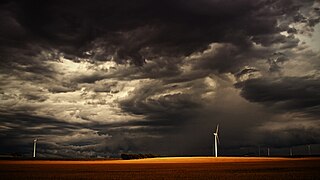The Greenough River is a river in the Mid West region of Western Australia.

Many countries and territories have installed significant solar power capacity into their electrical grids to supplement or provide an alternative to conventional energy sources. Solar power plants use one of two technologies:

Alinta wind farm is a wind power station at Walkaway, just south of Geraldton, Western Australia. It is owned by Infigen Energy and has offtake agreements with Alinta Energy and AGL Energy.

Wind power is one of the main renewable energy sources in the world. In Australia, wind power contributed 10% of the total electricity supply in 2020, and 37.5% of its renewable energy supply. Wind resource testing conditions in Australia are optimal, as abundant wind resources are located close to residential areas in the southern parts of the country and on the slopes of the Great Dividing Range in the east.

Solar power is a fast-growing industry in Australia. As of June 2023, Australia's over 3.52 million solar PV installations had a combined capacity of 32,095 MW photovoltaic (PV) solar power, of which at least 4,389 MW were installed in the preceding 12 months. In 2019, 59 solar PV projects with a combined capacity of 2,881 MW were either under construction, constructed or due to start construction having reached financial closure. Solar accounted for 12.4% of Australia's total electrical energy production in 2021.

Wind power became a significant energy source within South Australia over the first two decades of the 21st century. In 2015, there was an installed capacity of 1,475 MW, which accounted for 34% of electricity production in the state. This accounted for 35% of Australia's installed wind power capacity. In 2021, there was an installed capacity of 2052.95 MW, which accounted for 42.1% of the electricity production in the state in 2020.

Lake Bonney Wind Farm is a wind farm near Millicent, South Australia, Australia. The wind farm is south of, and contiguous with, Canunda Wind Farm. Both are built along the Woakwine Range - a line of stabilised sand dunes that once were coastal.
The Capital Wind Farm near Bungendore is the largest wind farm in New South Wales. It is part of the 6,000-hectare (15,000-acre) Capital Renewable Energy Precinct, along with nearby Woodlawn Wind Farm and the Capital East Solar Demonstration Plant.

Australia is the driest habitable continent on Earth and its installed desalination capacity has been increasing. Until a few decades ago, Australia met its demands for water by drawing freshwater from dams and water catchments. As a result of the water supply crisis during the severe 1997–2009 drought, state governments began building desalination plants that purify seawater using reverse osmosis technology. Approximately one percent of the world's drinkable water originates from desalination plants.
In 2016, Arizona had 268 megawatts (MW) of wind powered electricity generating capacity, producing 0.5% of in-state generated electricity.

Solar power in Mexico has the potential to produce vast amounts of energy. 70% of the country has an insolation of greater than 4.5 kWh/m2/day. Using 15% efficient photovoltaics, a square 25 km (16 mi) on each side in the state of Chihuahua or the Sonoran Desert could supply all of Mexico's electricity.

Solar power in Florida has been increasing, as the cost of solar power systems using photovoltaics (PV) has decreased in recent years. Florida has low electricity costs compared with other states, which makes individual solar investment less attractive. Florida ranks ninth nationally in solar resource strength according to the National Renewable Energy Laboratory and tenth in solar generation by the Solar Energy Industries Association.

Infigen Energy (Infigen), operating under this name since 29 April 2009, is a developer, owner and operator of renewable energy generation assets in Australia. Infigen's wind farm portfolio has an installed capacity of 557 MW. Most of Infigen's assets generate electricity from renewable sources and are eligible to sell Large-scale Generation Certificates (LGCs) under the mandatory Renewable Energy Target scheme, which operates in Australia under the Renewable Energy (Electricity) Act 2000. Since 2020, Infigen Energy has been a subsidiary of Iberdrola.
The Greenough River Solar Farm is a 10 megawatt (MW) photovoltaic power station located in Walkaway, Western Australia. When it opened in October, 2012, it was the country's first utility-scale solar farm. It remained Australia's largest solar PV system until 2014, when it was superseded by the 20 MW Royalla solar farm in Canberra. The Greenough River Solar Farm was built by Verve Energy and joint venture partners GE Financial Services. It uses over 150,000 thin film modules based on CdTe-PV technology provided by U.S. company First Solar. Its exact location is at Nangetty Walkaway Road, Walkaway, 50 kilometres southeast of Geraldton and covers an area of 80 hectares.

The Australian electricity sector has been historically dominated by coal-fired power stations, but renewables are forming a rapidly growing fraction of supply.

Wind power in Tennessee has most potential in East Tennessee along the North Carolina border. The state has not passed renewable portfolio standard legislation and there is just one utility-scale wind farm with 15 operating turbines and previously 3 test turbines. The Tennessee Valley Authority (TVA), based in Knoxville, imports wind-generated electricity into its service area which includes Tennessee. US Senator Lamar Alexander from Tennessee is an outspoken critic of wind power.

Renewable energy in South Africa is energy generated in South Africa from renewable resources, those that naturally replenish themselves—such as sunlight, wind, tides, waves, rain, biomass, and geothermal heat. Renewable energy focuses on four core areas: electricity generation, air and water heating/cooling, transportation, and rural energy services. The energy sector in South Africa is an important component of global energy regimes due to the country's innovation and advances in renewable energy. South Africa's greenhouse gas (GHG) emissions is ranked as moderate and its per capita emission rate is higher than the global average. Energy demand within the country is expected to rise steadily and double by 2025.
Badgingarra Wind Farm is a wind farm in the locality of Hill River northwest of the town of Badgingarra in Western Australia, about 200 kilometres (120 mi) north of Perth. It is owned by APA Group and located immediately north of the older Emu Downs Wind Farm which has the same owner.













